Ile-Alatau National Park
Ile-Alatau National Park (Kazakh: Іле Алатауы ұлттық паркі, Ile Alatauy ülttyq parkı ; Russian: Иле-Алатауский национальный парк, Ile Alatauskiy Natsional'nyy Park) is a national park in Kazakhstan. It was created in 1996 and covers about 200,000 ha. It is situated in the Trans-Ili Alatau mountains south of Almaty between Gorge Turgen in the east and Chemolgan River in the west. The National Park borders Almaty Nature Reserve, which is located around Pik Talgar.[1][2]
| Ile-Alatau National Park | |
|---|---|
_in_June.jpg.webp) View of Big Almaty Lake | |
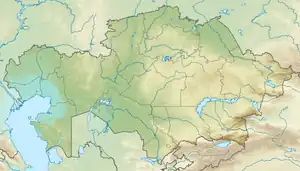 Location of the Ile-Alatau National Park 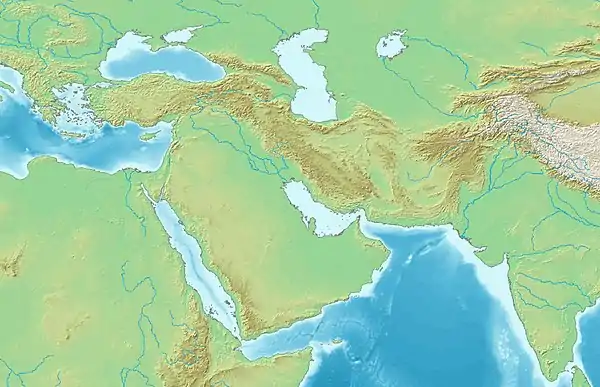 Ile-Alatau National Park (West and Central Asia) | |
| Location | Trans-Ili Alatau, Tian Shan |
| Nearest city | Almaty, Almaty Region, Kazakhstan |
| Coordinates | 43°5′0″N 77°5′0″E |
| Area | 200,000 ha (490,000 acres) |
| Established | 1996 |
The landscape includes woodlands, alpine meadows, glaciers and lakes, including Big Almaty Lake. Remarkable trees include apricot, maple, and apple. A total of 300 species of birds and animals have been recorded from the Ile-Alatau National Park.[3] The park is home to snow leopards, Central Asian lynx, Tian Shan brown bears, Central Asian stone martens, Siberian ibexes, bearded vultures and golden eagles. Other notable bird species found in Ile-Alatau National Park include Himalayan snowcock, ibisbill, Eurasian scops owl, and Eurasian three-toed woodpecker.[4][5][6] The park also protects specific species of deer whose antlers are believed to have medicinal properties.[7]
dd
=ddddddd
Flora
The flora of the natural park has more than 1,000 species, of which the overwhelming part accounts for the flora of the middle-mountain forest belt. There are more than 500 species of deciduous forests and more than 400 species of higher plants in spruce forests. 36 species are included in the Red Book.
In the lowlands there are Ostrovskiy tulip, Mushketov's curlicue, Alberta iris, Sivers apple tree, Altai holosemianus; in the middlelands - orange jaundice, Semenov's tufted shagreen, Alma mater, cortuza Semenova; in the highlands - Falconer liverwort, Tianshan Siberia, Kumbel hawk, Schmangauzia asteriata, Sossurea wrapped. The mosses listed in the Red Book, such as Pachyphysissidens largeifolia and Orthotrichum smoothened are in special need of protection. The red-listed saffron of Alatau (Crocus alatavicus) can be found in the Kok-Gailau tract.
From the set of useful plants of great interest is a group of fodder plants (more than 80 species): cobresia hairy, sedge narrow dense, fescue Krylov, bluegrass alpine and meadow bluegrass, fescue Tianshan, hedgehog, short-legged pinnate, species regeneration, clover, pea, chinna.[8]
Among tannic plants, the most valuable are various species of sorrel, mountain pea, and rhubarb. From the essential oil-bearing plants - angelica, juniper, wormwood. As natural dyes can be used cuffs, daubing, macrotonia, etc.
Widespread medicinal plants: fir, yarrow, mother and stepmother, rose hips, joester, valerian, juniper, dandelion, plantain, etc.
Among the food plants are especially valuable: apricot, apple tree, raspberry, currant, strawberry, strawberry, blackberry, barberry, sea buckthorn, rowanberry, hawthorn, rose hips.
Numerous ornamental plants: primroses, waterspouts, tulips, irises, small petals, bluebells, gentians, violets, different types of trees and shrubs.[8]
Fauna
The fauna of invertebrates has not been fully studied yet. However, by now more than 2000 species from 8 classes are already known.
The composition of some classes of insects has been partially revealed. Thus, from the order of beetles 252 species of beetles, 180 - staphylinids, 102 - leaf beetles; from the order of scaly or butterflies - 145 species of daytime moths; from the order of hymenoptera - 110 species of bees, 97 - swarming wasps, 33 - ants, and 30 ichneumon flies have been studied. Of all this diversity, only 24 species are included in the Red Book of Kazakhstan, including 3 species of mollusks (Bradybena senestrosa, Pseudonapeus shnitkova and Turcomylax cvetkova). The others belong to the class of insects: the Notable Hornbill, the Pretty Ladybird (order of dragonflies), the Short-winged Bolivaria (mantis), the Steppe Dabbit, the Semenov's Daisy, the Ershov's Jaundice, the Bedromylius, the Patrician.
The vertebrate fauna is represented by 245 species. In mountain rivers and streams there are 8 species of fish: naked and scaly ottomans, marinka, minnow, and in the river Turgen - acclimatized rainbow trout.
There are four species of amphibians, two of which (Danatin toad and Central Asian frog) are included in the Red Book of Kazakhstan.
Of the eight species of reptiles, lizards are common (Alai's googly and multicolored lizard), as well as snakes - common and water snake, multicolored and patterned snakes. More rare are venomous snakes - steppe viper and shield-monkey.[9]
The variety of natural conditions determines the species richness of birds. In total, there are 178 species in the national park. According to the character of their stay they are divided into three groups: nesting - 105 species, arriving for wintering - 18 species, migrating - 55 species. The Red Book includes 11 species (black stork, pygmy eagle, golden eagle, kumai, shahin, sickle-owl, eagle owl, saker falcon - flying; peregrine falcon, and big lentil - wintering).
Mammals 48 species. Typical mountain mammals include the Tianshan rodent, rock squirrel, red pika, gray marmot, Tianshan mouse, silver vole, stone marten, snow leopard, and ibex.
Along with species typical of mountains, there are also species typical of other ecosystems in the park: wolf, fox, bear, roe deer, red deer, wild boar, tolai hare, etc. The group of red-listed species consists of 7 species: brown Tianshan bear, snow leopard, stone marten, Central Asian river otter, Pallas' cat, Turkestan lynx and Indian porcupine.[9]
Landmarks
On the territory of the park there are burial mounds of the early Iron Age on the Assy plateau and near the Turgen Gorge, Sak burials on the banks of the Issyk River.
On the right bank of the Turgen River the traces of the strong earthquake, which occurred here more than 10 thousand years ago, were found. This debris strata in the form of rocks of bizarre shapes and various colors is a true monument of nature.[10]
The relict mossy Chinturgen spruce forests are also a natural monument, where islands of permafrost with ice thickness of 2–3 m are preserved under the cover of moss at a depth of 30–40 cm. Permafrost massifs located at such a low altitude are not found anywhere else in the Trans-Ili Alatau. The high-altitude landscape, which resembles the cold desert of the Inner Tien Shan, which is located along the axial part of the ridge at the Pass of "Prokhodnoy", is unique.[10]
Peak "Seven Needles Tuyuksu" is a peak consisting of seven rock formations, shaped like needles. The difficulty category is 4a.
The park also includes the Kaskelen river gorge.[11][12]
Gallery
 Near observatory.
Near observatory..jpg.webp) Watchtower in Big Almaty Lake.
Watchtower in Big Almaty Lake.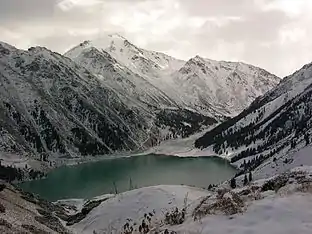 Lake in winter.
Lake in winter.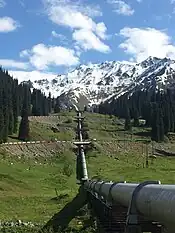 Water pipe from the lake.
Water pipe from the lake.%252C_Almaty_region%252C_Kazakhstan._October_2007.jpg.webp) Lake during a fog.
Lake during a fog.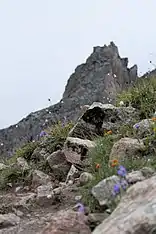 Wildflowers along the Bogdanovich Glacier trail.
Wildflowers along the Bogdanovich Glacier trail.
Panoramic view
References
- "Ile-Alatau National Park". almaty-kazakhstan.net. Retrieved 15 February 2014.
- "State National Park "Ile-Alatau"". welcometokazakhstan.com. Archived from the original on 24 February 2014. Retrieved 15 February 2014.
- "Ile-Alatau National Park". Weekenborg Solutions. Retrieved 9 July 2013.
- "Species With Materials Recorded in Ile Alatau National Park". Retrieved 9 July 2013.
- "Ile-Alatau national park". trekkingclub.kz. Retrieved 15 February 2014.
- "Tour Kazakhstan - Hidden Zhetysu Wonderland". bioexploration.org. Archived from the original on 9 March 2010. Retrieved 15 February 2014.
- Himes, Katherine (June 30, 2015). "Science and Culture Collide: Living and Working as a Science Diplomat in Central Asia". Science and Diplomacy.
Various special types of deer are protected for the specific purpose of harvesting blood from the horn. This blood is then used to create a traditional tincture, purported to cure many ailments—anemia, virility issues, and immune deficiency problems.
- Saparbayeva, N.A. "Роль Иле-Алатауского Государственного Национального Природного Парка в сохранении биоразнообразия полезных растений Казахстана". Экология: рациональное природопользование и безопасность жизнедеятельности: 65–67.
- "Фауна - ALATA". www.ile-alatau.kz (in Russian). Retrieved 2022-08-18.
- "Иле-Алатауский государственный национальный природный парк — HOSPITALITY KAZAKHSTAN Program" (in Russian). Retrieved 2022-08-18.
- Ecotourkz.com: Kaskelen Gorge
- Jura.lt: "Kazakhstan is becoming top player of Central Asian tourism industry", 27 April 2012


